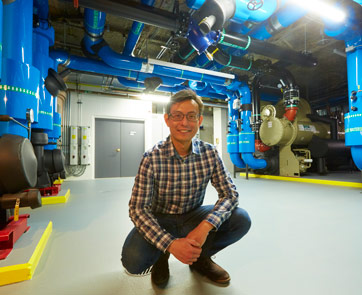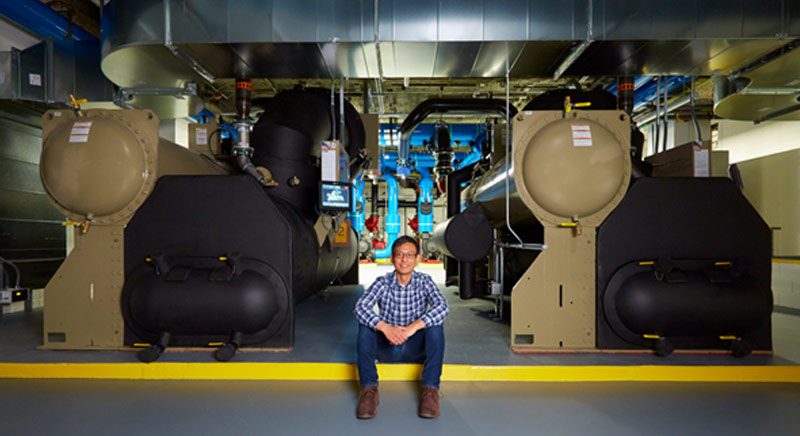By Jason Chan
I’ve been a mechanical engineer for almost 20 years and over the course of my career I have worked on a lot of interesting projects. But since becoming a facilities project engineer at the Rolling Meadows, Illinois site, I hadn’t yet worked on a project as BIG as this one.
Sometimes I wonder if people realize everything it takes to keep massive 24/7 operation buildings functioning day-to-day. It is complex and takes a lot of people and coordination that go beyond the noticeable work like building renovations and fixing plumbing outages. And let’s not forget the most important reason for keeping our facilities in great shape — the critical work our teams are doing inside these buildings.

Before coming to Northrop Grumman I worked at a mechanical construction company as a project manager and an estimator. After some time in that role, I needed a change and started to think about doing something different within the mechanical engineering world. One of the reasons I was interested in facilities was because it provided me with the opportunity to work in other disciplines of construction and building systems while also managing projects. Replacing two giant chillers that had been in operation for 34 years was just the type of challenge I would have hoped to work on.
“Replacing an HVAC system” may not sound particularly hard or exciting, but in this case it was both.
Imagine a massive chiller system that weighs more than two African elephants and is larger in dimension than the average master bedroom. Now take two of those, put them into an already constructed building, onto a freight elevator, through existing door frames and down narrow hallways.
It was no small feat.
The entire project took nearly five months and dozens of hands-on deck during that time.
The sheer size alone presented our first major obstacle. We had to figure out a way to bring the chillers through the narrow hallways in the lower level of the building and because of its massive size and weight, hallway dimensions and the weight capacity of the freight elevator had to be reviewed. We had only one option: disassemble and reassemble the units.

Disassembling the chillers had to be done by the manufacturer and required them to rent a warehouse and bring in the necessary equipment, cranes etc. in order to strip the chillers down to sections and sizes that would work for us. This took an entire team of people and about a week for the disassembly of just one of the chillers.
Even in pieces, the units were still too large for the space. We had to remove walls and even enlarge a few openings. Work had to be coordinated with many experts, contractors and our equipment manufacturers.
Reassembly also took a team of seven and two full weeks to complete both chillers.
The next big challenge was changing the way the chilled water system works — switching from a primary / secondary flow system to a variable primary flow system. Simply put, this switch would offer a better dehumidification process, create more energy efficiencies and make the chilled water going through the building even cooler. The benefits were clear, but we had to work for them.
The switching effort was important to ensuring that the environmental systems that regulate the temperature and humidity in the labs and work spaces remain within certain limits. Reworking the flow system was unique and required close coordination and technical reviews of the new systems ability to maintain the required flow, as well as the reconfiguration of existing equipment to meet the volume and pressure requirements. Originally, the system had four pumps and going through the switch would eliminate one set of pumps. Changing the piping systems required a lot of overhead piping to be completely reconfigured in the building.

Now that the project is completed, we are reaping the benefits of higher energy efficiencies and better dehumidification control. Overall, the new chillers have contributed to an emissions reduction of 372 MTCO2e.
While this was a big undertaking, seeing the end result was very cool. For me, the greatest part of this entire effort was seeing everyone involved work together to solve and resolve every challenge and barrier we faced. There are many people that contributed their time and effort from engineering to implementation that led to a fully operational chiller plant. Thanks to the team’s dedication and perseverance, we overcame countless obstacles to make this happen.

About Jason
Part of the Rolling Meadows facilities team, Jason Chan is a mechanical engineer and is responsible for designing and managing mechanical construction, mechanical infrastructure, hydronic heating and cooling, refrigeration, process piping, and plumbing systems. Originally from Hong Kong, Jason moved to the U.S. when he was a junior in high school. Before deciding to study engineering, Jason thought he wanted to work in finance but became interested in engineering after researching different types of jobs. When Jason is not working on large facility projects at work, you can likely find him on the soccer field with his daughters.